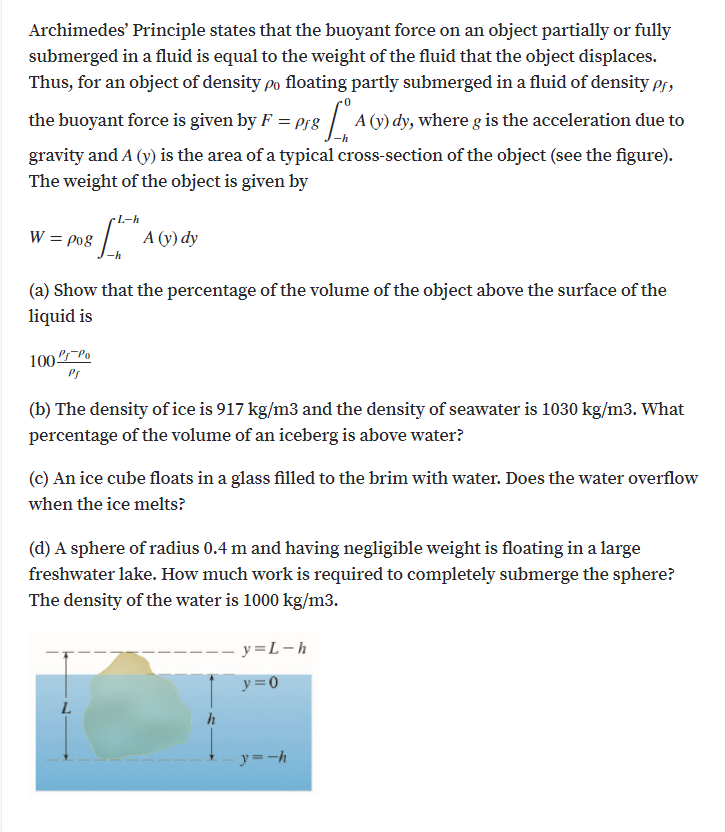Archimedes' Principle states that the buoyant force on an object partially or fully submerged in a fluid is equal to the weight of the fluid that the object displaces. Thus, for an object of density po floating partly submerged in a fluid of density pf, the buoyant force is given by F = prg | A(y) dy, where g is the acceleration due to ' = Pf8 gravity and A (y) is the area of a typical cross-section of the object (see the figure). The weight of the object is given by W = po8 A (y) dy (a) Show that the percentage of the volume of the object above the surface of the liquid is 100LLL (b) The density of ice is 917 kg/m3 and the density of seawater is 1030 kg/m3. What percentage of the volume of an iceberg is above water? (c) An ice cube floats in a glass filled to the brim with water. Does the water overflow when the ice melts?
Archimedes' Principle states that the buoyant force on an object partially or fully submerged in a fluid is equal to the weight of the fluid that the object displaces. Thus, for an object of density po floating partly submerged in a fluid of density pf, the buoyant force is given by F = prg | A(y) dy, where g is the acceleration due to ' = Pf8 gravity and A (y) is the area of a typical cross-section of the object (see the figure). The weight of the object is given by W = po8 A (y) dy (a) Show that the percentage of the volume of the object above the surface of the liquid is 100LLL (b) The density of ice is 917 kg/m3 and the density of seawater is 1030 kg/m3. What percentage of the volume of an iceberg is above water? (c) An ice cube floats in a glass filled to the brim with water. Does the water overflow when the ice melts?
Related questions
Question
100%

Transcribed Image Text:Archimedes' Principle states that the buoyant force on an object partially or fully
submerged in a fluid is equal to the weight of the fluid that the object displaces.
Thus, for an object of density po floating partly submerged in a fluid of density pr,
the buoyant force is given by F = prg A (y) dy, where g is the acceleration due to
gravity and A (v) is the area of a typical cross-section of the object (see the figure).
The weight of the object is given by
W = po8
А (у) dy
(a) Show that the percentage of the volume of the object above the surface of the
liquid is
100Po
Ps
(b) The density of ice is 917 kg/m3 and the density of seawater is 1030 kg/m3. What
percentage of the volume of an iceberg is above water?
(c) An ice cube floats in a glass filled to the brim with water. Does the water overflow
when the ice melts?
(d) A sphere of radius 0.4 m and having negligible weight is floating in a large
freshwater lake. How much work is required to completely submerge the sphere?
The density of the water is 1000 kg/m3.
- y=L-h
y=0
L.
h
y=-h
Expert Solution
This question has been solved!
Explore an expertly crafted, step-by-step solution for a thorough understanding of key concepts.
This is a popular solution!
Trending now
This is a popular solution!
Step by step
Solved in 3 steps with 3 images
